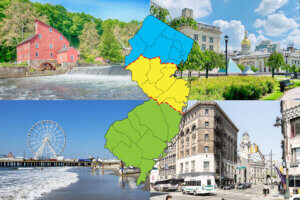Summary
Superstorm Sandy’s impact on coastal communities in New Jersey was unprecedented. This survey, conducted by the Monmouth University Polling Institute in conjunction with the New Jersey Shore Partnership Foundation and Monmouth University’s Urban Coast Institute, was undertaken to establish the full extent of the impact on the state’s coastal residents, their understanding of the rebuilding process, and their opinions on proposed policies to create a more resilient shoreline.
The telephone survey was conducted in late February 2013 with 501 New Jerseyans who live within one mile of the coastline, from the northern shore counties of Monmouth and Ocean to the southern shore of Atlantic and Cape May.
Storm Preparations and Impact
Most New Jersey coastal residents were caught off guard by the strength of Superstorm Sandy, with 62% saying it was more serious than expected. About half of New Jersey’s coastal residents (49%) expect that a similar storm will occur sometime in the next ten years. Only 26% say Sandy was a once in a lifetime event.
Seven-in-ten coastal residents (71%) report that they were either ordered or advised to evacuate before the storm, but only 34% actually did. Another 7% left while the storm was underway and 5% had to leave after the storm passed. Overall, 47% of coastal residents who live in a Sandy evacuation area say they are now more likely to heed future evacuation warnings, while 10% are less likely to do so.
More than half (56%) of New Jersey coastal residents report that their home or business suffered damage from Sandy. Nearly 1-in-10 of these residents report that their property was totaled, i.e. that the loss exceeded half of their home’s pre-storm value.
Six-in-ten Jersey Shore residents (61%) report that they have fully recovered from Sandy. This compares to 77% of New Jersey residents statewide who say the same. Ten percent of coastal residents say it will take them about a year to recover fully, 4% say it will take longer, and 3% feel they will never fully recover.
Five percent of coastal residents are not currently in the same home they lived in before Sandy hit. Reports of home displacement are higher in Ocean County (11%) than in Monmouth County (6%) or along the southern shore (3%).
Only 30% of homeowners with damaged properties say that they expect all or most of their losses to be covered by insurance. Another 23% say some amount will be covered while 26% say nothing will be covered. Despite Sandy’s devastating impact, most coastal homeowners (59%) say they would never consider selling their property to the town or county to be turned into open space.
Flood Zone Guidelines
Just over half of New Jersey coastal homeowners (53%) report that they carry a federal flood insurance policy on their property. It is worth noting that a 2007 survey of New Jersey coastal residents found that 69% of homeowners reported carrying flood insurance. The higher coverage prevalence reported in the prior poll may reflect an inaccurate assessment among some homeowners that they were indeed covered for flood damage.
Just over one-third (36%) of coastal residents report that they live in a designated pre-Sandy flood zone while 41% report that they do not. Tellingly, nearly 1-in-4 (23%) coastal residents say they are unsure whether their home is in a flood zone.
Confusion over designated flood zones has only grown with the post-storm release of FEMA’s Advisory Base Flood Elevation (ABFE) maps. As of late February 2013, just 22% of coastal homeowners had a very good understanding of how these guidelines would affect them and another 24% say they understand the proposed ABFE maps somewhat well. As a result, 22% of coastal homeowners believe they would be required to elevate their homes if they were to rebuild and 39% are unsure about this.
New Jersey coastal homeowners were asked whether they would consider elevating their house if their property was included in a new flood zone. Just under half say they would definitely (18%) or probably consider (26%) doing this. However, more would consider it if the out-of-pocket costs are low or the savings on annual flood insurance turned out to be significant.
Coastal Protection and Rebuilding Policies
Most New Jersey coastal residents (59%) feel that current efforts to protect their local waters and beaches are about right. Another 30% feel that not enough is being done and just 5% say there is too much emphasis on coastal protection. These results are statistically similar to a pre-Sandy poll conducted in 2009. Two-thirds of residents who had no damage from Sandy (66%) and 6-in-10 of those with some damage (59%) feel current efforts have been about right. However, just 43% of those with significant home damage feel the same, compared to 43% of this group who say there has been too little effort.
A majority of coastal residents (56%) say that government should handle most of the costs for projects to reduce damage from future storms and other coastal hazards. Another 20% say that coastal property owners should be primarily responsible. These results are similar to pre-Sandy polls conducted in 2007 and 2009.
Even though coastal residents feel that government should handle the cost of hazard reduction projects, a majority (55%) say they would support an increase in local taxes to fund these efforts. This finding is also similar to pre-Sandy poll results.
Nearly 9-in-10 coastal residents (89%) are in favor of requiring stricter storm-resistant building codes in areas affected by Sandy and 8-in-10 residents (83%) favor a continual beach replenishment program. Three-in-four residents (76%) specifically say that beaches should be replenished when they are washed away by a storm, which is higher than the 66% who said the same in 2009.
Fully 8-in-10 residents support building bulkheads, jetties, seawalls and other hard structures (82%), as well as sand dunes and other natural features that may block ocean views (80%). However, residents are divided on whether towns should be allowed to require easements from private property owners to accomplish this – 42% say that towns should have this power and 33% say that individual homeowners should be allowed to decide. Support for giving towns the authority to require easements is much higher among Ocean County residents (62%) than it is among those in Monmouth County (35%) or along the southern shore (40%).
Similarly, 79% of coastal residents support using tax dollars to restore existing wetlands and bays to better absorb storm surges and flooding. In general, 72% of New Jersey coastal residents support the public purchase of existing natural coastal areas for conservation purposes.
About 3-in-4 coastal residents (74%) support allowing beachfront homeowners to rebuild only if they agree to have dunes or sea walls placed in front of their property even if it blocks their ocean view. Support is particularly widespread among those who would be impacted the most – waterfront home dwellers (82%).
Seven-in-ten coastal residents (71%) support creating a state commission to coordinate planning and rebuilding along the shore. Nearly 2-in-3 coastal residents (64%) also support giving towns the right to impose a short-term moratorium on rebuilding in high risk areas. And more than 6-in-10 coastal residents (62%) support policies that would prevent any new construction or development in high flood-risk areas.
A majority of coastal residents (55%) support allowing state regulators to determine which areas of the shore can or cannot be rebuilt based on storm risk, while 40% of coastal residents oppose giving state regulators this power.
Fewer than half (47%) of coastal residents support using government funds from the “Blue Acres” program to buy private property in high risk areas. Another 35% oppose this proposal and 18% are unsure. Among coastal residents, waterfront property dwellers (60%) are more supportive of this type of program. In general, only 41% of New Jersey coastal residents support the idea of public purchase of private homes located in high risk areas regardless of the funding source.
SURVEY INSTRUMENT
A. LIVING ON THE COAST
A1.Do you own or rent the apartment or house where you lived when Superstorm Sandy hit? [IF “Rent”, ASK: Was this rented as your permanent home?]
A2.Is this home a waterfront property right on the beach or bay, within a few blocks of the beach or bay, within one mile?
A3.How much of the year do you live in this home – 10 to 12 months, 6 to 9 months, or less than 6 months?
A4.How many years have you lived in this town, or have you lived here all your life?
B. COASTAL POLICY
B1.Do you think current efforts to protect coastal waters and beaches in your local area are too much, too little, or about right?
B2.Would you support or oppose efforts to protect the coastal waters, shoreline, and beaches in your town if it meant you would have to pay more in local taxes? [PROBE: Is that strongly or somewhat (support/oppose)?]
B3.In general, when beaches are washed away from a storm, should they be replenished with new sand or should they be left as is?
B4.I’m going to read you some possible ways to preserve coastal habitats and reduce storm damage. Please tell me whether you would support or oppose these efforts in your local area. [ITEMS WERE ROTATED] – Would you strongly support, somewhat support, somewhat oppose, or strongly oppose doing this in your local area?
A. Building bulkheads, jetties, seawalls and other hard structures?
B. Building sand dunes and other natural buffers?
C. Public purchase of existing natural coastal areas for preservation?
D. Public purchase of private homes located in high risk areas?
E. Preventing any new construction or development in high flood risk areas?
B5.Would you support or oppose building sand dunes and other natural features to protect your town’s beaches, property, and people if it meant ocean views would be restricted? [PROBE: Is that strongly or somewhat (support/oppose)?]
B6.If some of these dunes need to be placed on privately owned waterfront property, should towns be able to require easements from those homeowners or should the individual homeowners be allowed to decide whether they will agree to this?
B7.Who should pay for most of the cost for projects designed to reduce damage from storms and other coastal hazards [ITEMS WERE ROTATED] – government OR coastal property owners?
B8.Do you strongly support, somewhat support, somewhat oppose, or strongly oppose the following proposals: [ITEMS WERE ROTATED]
A. Allowing beachfront homeowners to rebuild only if they agree to have dunes or sea walls placed in front of their property, even if it blocks their view of the ocean?
B. Allowing state regulators to determine which areas along the coast can or cannot be re-built based on storm risk?
C. Using government funds from the “Blue Acres” program to buy private property in high risk areas of the shore?
D. Continuing to replenish the coast line with sand every few years?
E. Creating a state coastal commission to coordinate planning and rebuilding along the shore?
F. Giving towns the right to impose a short term moratorium on rebuilding in high risk areas?
G. Requiring stricter storm-resistant building codes in areas affected by the storm?
H. Using tax dollars to restore existing wetlands and bays to better absorb storm surges and flooding?
C. STORM PREPARATION
C1.Was Superstorm Sandy as serious as you expected it to be, more serious or less serious?
C2.Do you think that this was a once in a lifetime storm – or do you think that this type of storm is likely to happen again in the near future?
C2A.Do you think it will happen in the next year, the next five years, the next ten years, the next 25 years, or longer than that?
C3.Thinking about your own preparations for Sandy, the next time a big storm is predicted to hit New Jersey, will you do more to prepare, less to prepare, or about the same as you did to prepare for this storm?
C4.Did you ever evacuate or leave your home because of Sandy, or not?
C4A.When did you leave your home – before the storm arrived, while the storm was actually underway, or after the storm had passed?
C5.Before the storm, were you in an area where people were ordered or advised to evacuate, or not?
C5A.Was that a mandatory order or just an advisory?
[NOTE: Question C5B was asked of those ordered or advised to evacuate in C5; n=316, m.o.e=± 5.5]
C5B.Will you be more likely, less likely, or about as likely to heed evacuation orders and advisories in future storms?
D. STORM IMPACT
d1.Would you say your family has fully recovered from the storm, partially recovered, barely recovered, or not recovered at all?
d2.How long do you think it will take you to fully recover – within the next few weeks, within the next few months, within the next year, about 2 or 3 years, more than 3 years, or do you feel you will never fully recover?
d3.Are you currently living in the same place you lived before Sandy hit?
[NOTE: Question D3A was asked of those who said they are not living in the same place in D3; n=31, m.o.e=± 17.6]
D3A.When do you expect to be able to get back into your home – within the next six months, within a year, longer than that, or never?
D4.Did you have a federal flood insurance policy on your home or contents last year, or not?
D4A.Was that on your home’s structure or contents, or both?
D5.Did your home or business suffer damage because of the storm?
[NOTE: Questions D6 and D7 were asked of those who said their home or business suffered damage in D5; n=268, m.o.e=± 6.0]
D6.Was the damage to your primary home, secondary home, business, or other income property? [Note: Results add to more than 100% because multiple responses were accepted]
D7.Was this damage caused by flood waters, wind, falling trees, fire, or power outages? [Note: Results add to more than 100% because multiple responses were accepted]
[NOTE: Questions D8 through D10 were asked of those who said their primary or secondary home suffered damage in D6; n=256, m.o.e=± 6.1]
D8.What is your estimated total cost in damages and losses incurred on YOUR HOME as a result of the storm? Please do not include damage to any other property in this estimate.
D9.And is that more than half or less than half of your home’s total value before the storm?
D10.How much of the financial damages or loss to your home will your insurance cover – all or nearly all, most, some, just a little, or none at all?
[NOTE: Question D11 was asked of homeowners that said their primary or secondary home suffered damage in D6; n=214, m.o.e=± 6.7]
D11.What are you most likely to do with this home – repair it, tear it down and rebuild on this property, rebuild somewhere else, leave it as is, or sell it?
[ASK EVERYONE:]
D12.Was your home in a designated flood zone before the storm or not, or aren’t you sure?
D13.How much have you read or heard about the new FEMA Advisory Base Flood Elevations adopted by the state last month – a lot, a little, or nothing at all?
D14.How well do you understand how these new guidelines affect your property – very well, somewhat well, not too well, or not at all well?
D15.As far as you know, would the new flood maps require you to build your house higher than it is now if you had to rebuild, or not?
D16.The new guidelines define expanded flood zones and also how high homes must be built in those zones in order to qualify for flood insurance. Based on what you may have heard so far, are these new guidelines too strict, not strict enough, or about right?
[NOTE: Question D17 was asked of all homeowners; n=410, m.o.e=± 4.8]
D17.If it turns out you are in one of these expanded flood zones, would you definitely consider, probably consider, or not consider elevating your home in order to meet these new standards?
[NOTE: Questions D18 and D19 were asked of homeowners in flood zones; n=365, m.o.e=± 5.1]
D18.Would you consider it if your out of pocket cost was $25,000? How about if it cost you $50,000? How about $100,000?
D19.Would you definitely consider, probably consider, or not consider elevating your home if it saved you $3,000 a year on flood insurance? Would you consider it if it saved you about $25,000 a year on flood insurance?
[NOTE: Question D20 was asked of all homeowners; n=410, m.o.e=± 4.8]
D20.Would you definitely consider, probably consider, or not consider selling your property to the town or county to be turned into open space?
E. DEMOGRAPHICS
[ASK EVERYONE:]
Now just a few final questions so we can classify your answers –
E1.What was the last grade in school you completed?
E2.What was your age on your last birthday?
E3.How many people live in your household, including yourself?
E3A.E3A. How many are children under the age of 18?
[NOTE: Question E4 was asked of all homeowners; n=410, m.o.e=± 4.8]
E4.Are you currently paying a mortgage or other loan on your home, or not?
E5.Are you of Latino or Hispanic origin?
E6.Are you white, black or of Asian origin?
E7.What town do you live in?
E8.So that we can group all answers, is your total annual family income before taxes: Under $50,000; from $50,000 to just under $100,000; from $100,000 to just under $150,000; or $150,000 or more?
E9.Respondent gender (from observation)
Click on pdf file link below for complete report with full methodology and results by key demographic groups.




